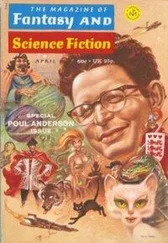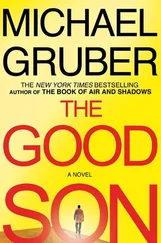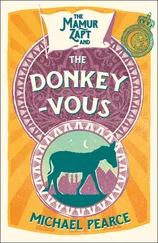“Maybe,” I said, “but where is the well? Bracegirdle said it was a secret even in Shakespeare’s time. It could be under a factory or a housing development.”
“True. And in that case we’ll have to announce it publicly and turn the whole mess over to the authorities. Which I sometimes think we should have done from day one. But”-here an uncharacteristically wolfish expression appeared on the Map of Ireland-“I sure would like to find that play. So we can only hope that the well is still bubbling away, forgotten for centuries.”
After that she made more coffee and we drank it with Jameson whiskey in it. We talked about family, I recall, and children, and their joys and discontents. I rather regretted not liking her son and decided that it was an aspect of my craziness and resolved to be more agreeable to him in future. After some time had passed in this desultory fashion, Klim emerged with a glum look.
“I am sad to say that this ciphertext does not generate plaintext from any writing of William Shakespeare that is recorded by history. This is not deadly for us, because as I believe I have said earlier, we can run guessed probable plaintexts along the ciphertext and see if we get something intelligible and this I have started to do, but I desired to have some of your Irish coffee at this time.”
This was provided, and I asked him if he had found something intelligible yet.
“Yes, of course, we start with the commonest words in English and see if the ciphertext gives us, let us say, a the in either direction using a standard tabula recta. Of course Bracegirdle could have used a nonstandard tabula, but he has not before this, so let us suppose he is hurried and wished to stay simple. So we use the computer to query if any three letters of the ciphertext will generate a t-h-e trigram as part of our key, and you see here that we do: both TKM and WLK give us the , and when we run that key back against this ciphertext it gives us ADI and DEG , which fortunately are both trigrams common in English. Similarly running and gives us one hit and the plaintext FAD , which is also a good English trigram. Running be gives two hits, and we get ENDF for the plaintext and also a little bonus, because the first be comes right before that the we have already discovered, and so we know that be the is part of the key text. And so we go on from here. Each little advance gives us more of the plaintext and more of the key text and the two decipherings reinforce each other, which is why the running key based on a book is so weak. For this reason the KGB only used almanacs and trade reports with many tables of numbers, so the entropy is higher. Now the next word we try should be is or of, I believe…”
“No,” said Mary Peg, “try Jesus .”
“This is religious advice, my dear?”
“No, the word. You said you ran the key against the complete works and come up empty?”
“Yes. Aside from some purely random runs of pseudosense.”
“But he wrote one thing that’s not in his published works. His epitaph.”
She ran to a shelf and pulled out Schoenbaum’s Shakespeare’s Lives , and there it was on the first page:
Good friend for Jesus’ sake forbear To dig the dust enclosed here. Blessed be the man that spares these stones And cursed be he that moves my bones.
“On second thought,” she said, “it should be with the archaic spelling. I think it’s in Wood’s book.”
It was. Klim entered the old spelling into the Vigenère solver and it worked, giving us:
fromguystowrheadingeduesout
hseteightysevendegreeseachsyd
esheliethfourfadomsandfoot
belowcopyngeintheeastwall
“This seems plain enough. One stands upon a place called Guy’s Tower and sets Bracegirdle’s instrument so that the zero point in the center is pointing due south by the compass set in it. Then the arms are placed at eighty-seven degrees, and then I suppose one must have a man with a flag walk out, and one looks in the eyepiece until the two images of the flag join and there is your distance and direction. Then when you find this well, one lowers oneself down on a rope with a candle stuck to one’s head with hot grease and there at a depth of…what is a fadom ?”
“A fathom,” said Mary Peg. “Six feet.”
“Yes,” said Klim, “so at a depth of let us say seven point six meters in the east wall of this supposed well we shall find your play. Or an empty hole. If we knew where this ‘Guys Towr’ was.”
“It has to be Warwick Castle,” she said confidently. “Bracegirdle wrote that you could see the castle from the ruins of St. Bosa.”
A moment on the Internet confirmed that there was indeed a Guy’s Tower on Warwick Castle, and on the south side too. I said, “That’ll be an interesting experience. Trying to sight off the top of a major tourist attraction while a man with a flag walks through the suburbs.”
But Klim’s fingers were already flying on the keys, and in a few minutes the screen showed a view from above the tower battlements of a castle. It appeared to have been taken from about twenty feet up.
“Very impressive,” I said. “This is a commercial satellite picture?”
“No, it is U.S. military. I have accessed it through an anonymous link but still we cannot stay on it very long.”
“How did you do that?” I asked.
“He’s a spy,” said Mary Peg with something like pride.
“I am a retired Polish spy, perfectly harmless. But I retain some knowledge of this sort of thing. America has the worst security of any nation, it is well known in those circles, a kind of joke in fact. Now we shall use some tools to drop a smart bomb on Mr. Shakespeare’s play.” More clicking and a red grid appeared over the picture and a palette of drawing tools sprang up along one edge of the screen. He said to Mary Peg, “My dear, if you could just measure that device?”
“Three feet exactly,” she replied after some manipulation of a tape measure.
“So…let us see, ninety-one point forty-four centimeters, which we center on the north-south diameter of this tower…so…and we then draw a line from either end at eighty-seven degrees from that base and we generate two lines which intersect…so. As you say, X marks the spot. We need not go up on the tower and bother the tourists. Thank you, United States Air Force satellite-based tactical program.” He pressed a key and the printer growled. I looked at the printout. Due south of the castle and veering off to the west was what looked like a plowed field bordered by copses of trees. The red lines from the tower converged in one of the dark little woods.
“How accurate do you think this is?” I asked Klim.
He shrugged. “As accurate as it was in 1611 at any rate. There does not seem to be a car park and lemonade kiosk there, so perhaps your well is still lost.”
I called Crosetti again and told him what I wanted him to do. It took quite a while. What a lot of cleverness and effort expended on a fraud, how many nice people would be disappointed! A perfect symbol of my life.
Carolyn Rolly wept for what seemed like a long time after Crosetti told her what had happened to her kids and to Harlan P. Olerud at Crosetti’s mother’s house in Queens, and then she insisted on calling there to talk to them until Crosetti managed to convince her that it was late at night in New York instead of the early morning it was in Zurich. Then his cell phone delivered a call from a man from Osborne Security Services who said that a plane was waiting at a local airport and they said good-bye to Amalie, with whom Carolyn had struck up a surprisingly warm relationship, surprising given the differences in their backgrounds and general approach to life. Perhaps, he thought, it was the commonality of motherhood and the peculiar situation of both sets of children bearing a similar horrible stress. With his usual curious eye, Crosetti watched the two women exchanging embraces. They did not really resemble each other physically, but both presented to the world the same air of solid particularity. He couldn’t imagine anything really changing either of them: Carolyn and Amalie, what you saw was what you got, although Amalie was honesty incarnate and Carolyn lied like a snake. Had Carolyn been blond, he concluded, they might have been two sisters, the good one and the bad.
Читать дальше












